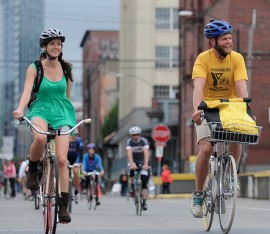
(Photo © J. Maus/BikePortland.org)
Ciclovias, the global term for what we call Sunday Parkways here in Portland, are nothing short of a revolution. Started in Latin America in the 1960s and made widely known by Bogota, Colombia, the events have spread like wildfire across North America in the last decade.
But with city budgets being very tight these days, programs like Sunday Parkways aren’t likely to survive the axe. Now, a new study, Do Health Benefits Outweigh the Costs of Mass Recreational Programs? An Economic Analysis of Four Ciclovía Programs, published in the Journal of Urban Health will help make the case that they’re worth the investment.
“The very low per user costs of the Ciclovías in comparison with other programs for physical activity promotion are striking.”
The study analyzed the costs and participation numbers of four ciclovia events: the original Ciclovia in Bogota; the Via RecreActiva in Guadalajara (which I participated in back in 2009); the Medellin Ciclovia; and the Sunday Streets events in San Francisco (which are similar to our Sunday Parkways).
Researchers talked to event managers and organizers to estimate the number of people participating in each event, what type of activities they did during the event, and how long they spent doing them. The goal was to determine how many people at the event could be considered “physically active users” and then plug that number into other data.
In Bogota’s Ciclovia, for instance, the researchers determined that, “the prevalence of physically active adult users” was estimated to be 35.7%.” They defined “physically active” as per the World Health Organization (WHO) which qualifies it as at least 150 minutes of moderate exercise or 75 minutes of vigorous activity per week. (Researchers realized that some people would do physical activity whether they were at the Ciclovia or not, so they asked about that in a follow-up question and then adjusted their numbers accordingly.)

(Photo © J. Maus/BikePortland.org)
Once they determined the number of physically active participants, they then did a detailed analysis on the cost of each event in order to arrive at a “Total Cost per user.” Researchers looked at both operational costs (truck rentals, first aid kits, traffic cones, and so on) and users costs (the equipment needed to participate in the event like helmets, skates, bikes, and so on).

With that number, researchers determined the direct health benefit (DHB), which they defined as the “amount of money a physically active adult saves in annual direct health and medical costs for preventing chronic diseases.”
They then calculated the cost–benefit ratio by dividing the total direct health benefit derived from each Ciclovía program by the total costs of each program.
The results of all this number-crunching showed that these programs are definitely worth the investment because they reduce health costs and allow people to live longer — and therefore more economically productive — lives.
Taking San Francisco’s Sunday Streets program as an example, the researchers found that with the event’s total annual project cost of $1.7 million (based on 52 events) and an annual cost per capita of $70.50, the projected cost-benefit ratio was 2.32. “This indicated savings in direct medical costs of US $2.3 for every dollar invested in the program if the program occurs regularly every week.” (*Note: The SF event only happens nine times but the researchers based their calculations on a weekly event projection.)
Using a model known as the Health Economic Assessment Tool for Bicycling, where just the people who ride bikes at Sunday Streets are taken into account, the “mean annual benefit for mortality prevention” ranged from $5.1 to $5.8 million.
In conclusion, the researchers say that their results, “support the implementation of this type of program as part of public health efforts to promote PA [physical activity] in urban settings from developed and developing countries.”
The researchers also used their findings to compare the relatively low cost ciclovia events with other methods of encouraging physical activity in cities…

A key takeaway from this study is that, while previous research has looked at the cost-benefit ratio of bicycling or active transportation — it has done so based on a relatively expensive non-motorized infrastructure investment (like a trail project). Ciclovia-type events require no hard infrastructure investment because they use existing roads and facilities.
Here’s how the researchers put it (emphasis mine):
“The very low per user costs of the Ciclovías in comparison with other programs for physical activity promotion are striking. Clearly using existing infrastructure built and maintained for motorized transport contributes substantially to the positive cost–benefit ratio. The large number of users, and the potential for an even greater proportion of urban populations to participate in Ciclovías due to the ubiquitous presence of road networks and their relative underutilization during certain hours suggests that with appropriate multisectoral partnerships, political support, and effective management and promotion, many more cities can support Ciclovías on the scale of Bogotá.”
With programs like this under the budget microscope, this study should be a welcome arrival for city staffers and advocates everywhere.
— For more on the study, read the abstract here (it costs $35 to download).

